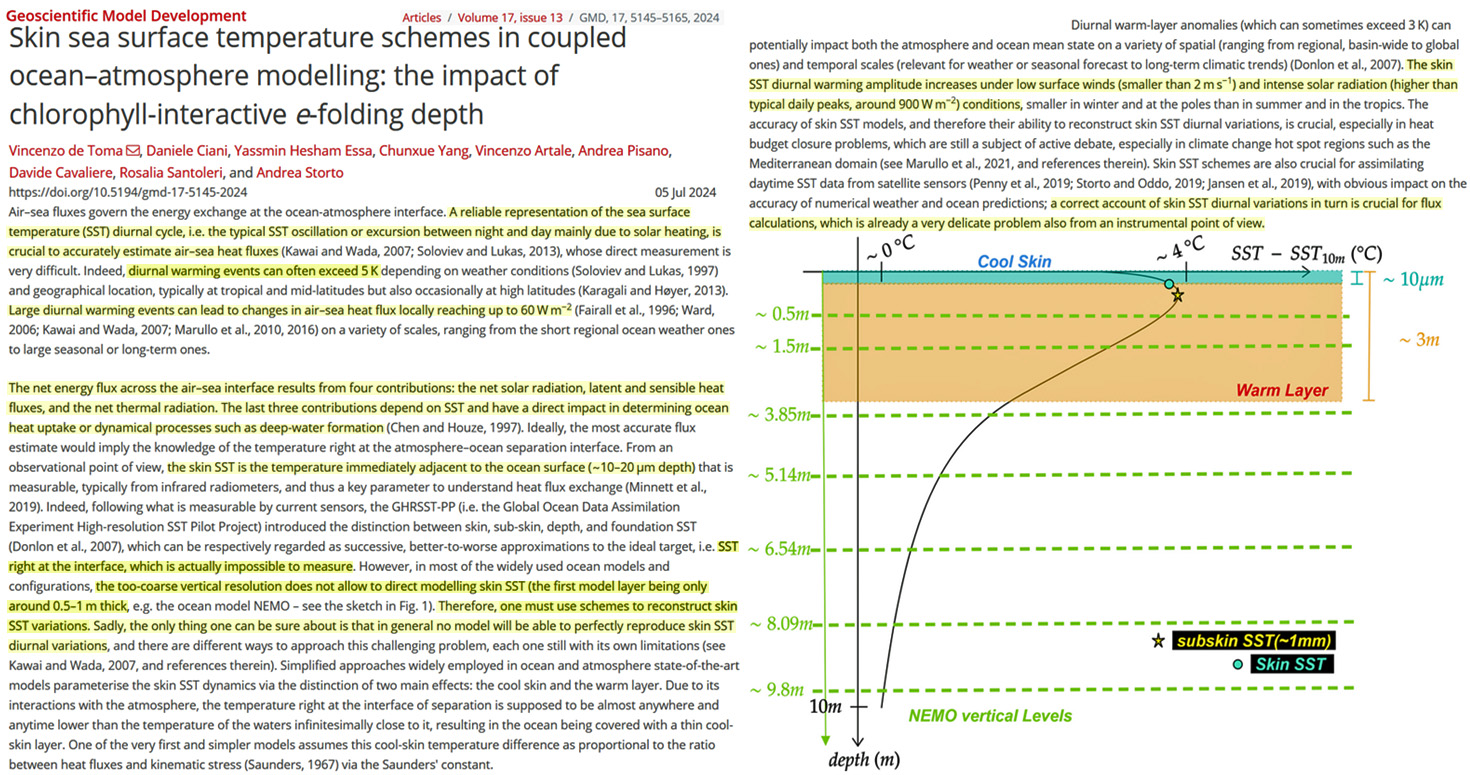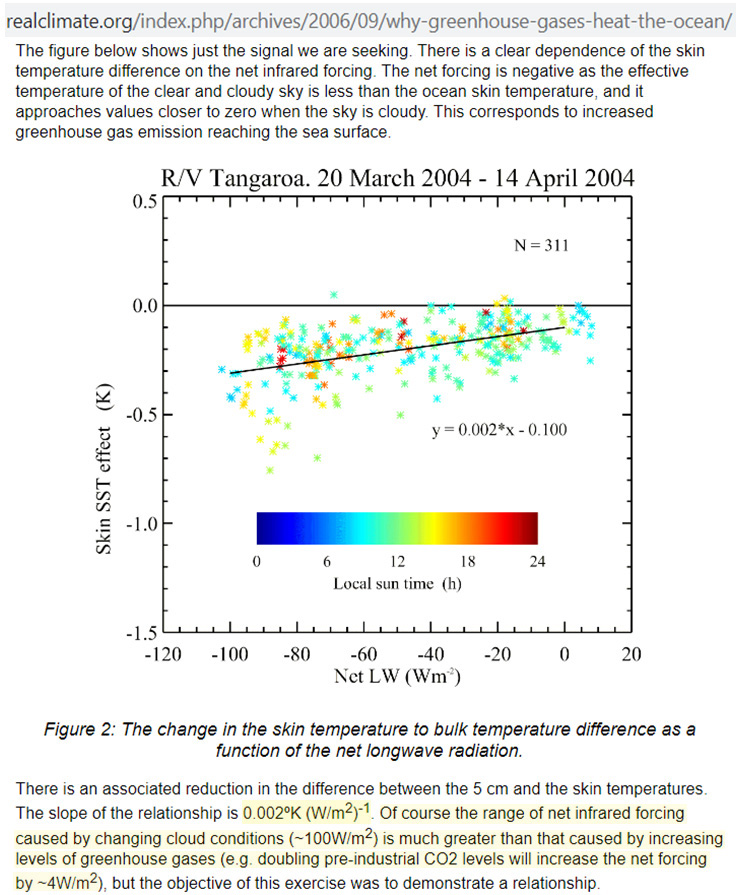Scientists do not even mention CO2 concentration changes as a factor in ocean warming.
A new study reveals the limit of the greenhouse gas-induced longwave radiative impact extends only to the ~10 μm (0.01 mm) skin layer – the ocean-air interface – and no deeper.
Determining the sea surface temperature (SST) variation at this skin depth is critical to any attempt to quantify or calculate the impact of greenhouse gases like CO2 on ocean temperatures. Yet scientists admit such temperature variations are “impossible” to measure at this depth.
Instead, temperature variations in the skin layer must be “schemed” (which is little different than saying guessed) using models that only begin at the 500 to 1,000 mm (0.5 to 1.0 m) layer depths. This means, of course, that CO2’s effects on ocean temperatures are also impossible to measure.
“SST right at the interface, which is actually impossible to measure”
“…the too-course vertical resolution does not allow to direct modeling skin SST (the first model layer being only around 0.5 – 1.0 m thick”…). Therefore, one must use schemes to reconstruct skin SST variations.”
The authors of the paper actually do not even mention greenhouse gas-induced changes as factors affecting – much less driving – variations in ocean heat flux at the interface. The only causal factors mentioned in determining energy changes in the ocean-air system critical to “global warming” are variations in solar radiation and wind speed.
“The net energy flux across the air-sea interface results from four contributions: the net solar radiation, latent and sensible heat fluxes, and the net thermal radiation. The last three contributions depend on SST and have a direct impact in determining ocean heat uptake…”
“The skin SST diurnal warming amplitude increases under low surface winds (smaller than 2 m s−1 ) and intense solar radiation (higher than typical daily peaks, around 900 W/m²) conditions…”

Image Source: de Toma et al., 2024
Apologists for anthropogenic global warming (AGW) have advanced the hypothesis that greenhouse gas-induced changes in downwelling longwave radiation (DLWR) can affect changes in the thermal gradient at the skin layer depths, thus reducing or enhancing cooling.
However, in a blog article he composed for RealClimate back in 2006, Dr. Peter Minnett reported the results of a 2004 experiment using cloud-induced DLWR changes as a proxy for CO2-induced DLWR changes. Clouds needed to be used as a proxy because CO2’s longwave effects are too small to detect, as they are acknowledged to be 50 times smaller than cloud longwave effects.
The results of the experiment revealed the thermal gradient change was merely 0.002°C (two one-thousandths of a degree) for a ~100 W/m² DLWR change in cloudiness. Because cloud forcing is 50 times larger than CO2 forcing (~2 W/m² since 1750), CO2’s impact, dividing the 0.002°C cloud value by 50, is thus 0.00004°C. This is four one-hundred-thousandths of a degree.
Obviously this specified quantification marks how ridiculous it is to believe that CO2 can be a causal mechanism – much less a driving mechanism – for global ocean temperature changes.






So if 90 to 93% of global warming is in the oceans, then AGW is causing effectively none of it. What is warming the oceans from above is the sun. Even the article analysis is bogus because heat cannot flow from the atmosphere to the oceans with violating the 2nd Law because almost everywhere and at all times the air above the oceans is cooler than the oceans and therefore cannot warm them.
This talk of 4 100,000ths of a degree of warming in the first 10 microns of the oceans does not explain how the warmer waters below 10 microns gets warmed. After all, heat rises.
RealClimate.org guys showed nothing :
The spectral emission of clouds (condensed matter at a temperature close to the SST) has nothing to do with the 15µm emission of the CO2.
Wien’s displacement law states that a black-body which radiation peaks at 15µm has a temperature of -80°C.
One can add all the W/m² of 15µm photons he/she want, it’s like adding -80°C radiators in the atmosphere : they will heat nothing on Earth.
Wien’s law is known by anyone with a back-ground in basic physics since more than a century but it seems the AGW crowd still haven’t gotten the memo.
“The results of the experiment revealed the thermal gradient change was merely 0.002°C (two one-thousandths of a degree) for a ~100 W/m² DLWR change in cloudiness. Because cloud forcing is 50 times larger than CO2 forcing (~2 W/m² since 1750), CO2’s impact, dividing the 0.002°C cloud value by 50, is thus 0.00004°C. This is four one-hundred-thousandths of a degree.”
One cannot physically measure such tiny entities. So we talking air……
[…] Learn extra at No Tips Zone […]
[…] Read more at No Tricks Zone […]
[…] Read more at No Tricks Zone […]
[…] Read more at No Tricks Zone […]
[…] Read more at No Tricks Zone […]
[…] New Study: CO2 Effects On Ocean Temps ‘Impossible’ To Measure…Must Be ‘Schemed’ With Model… […]
[…] New Study: CO2 Effects On Ocean Temps ‘Impossible’ To Measure…Must Be ‘Schem… […]